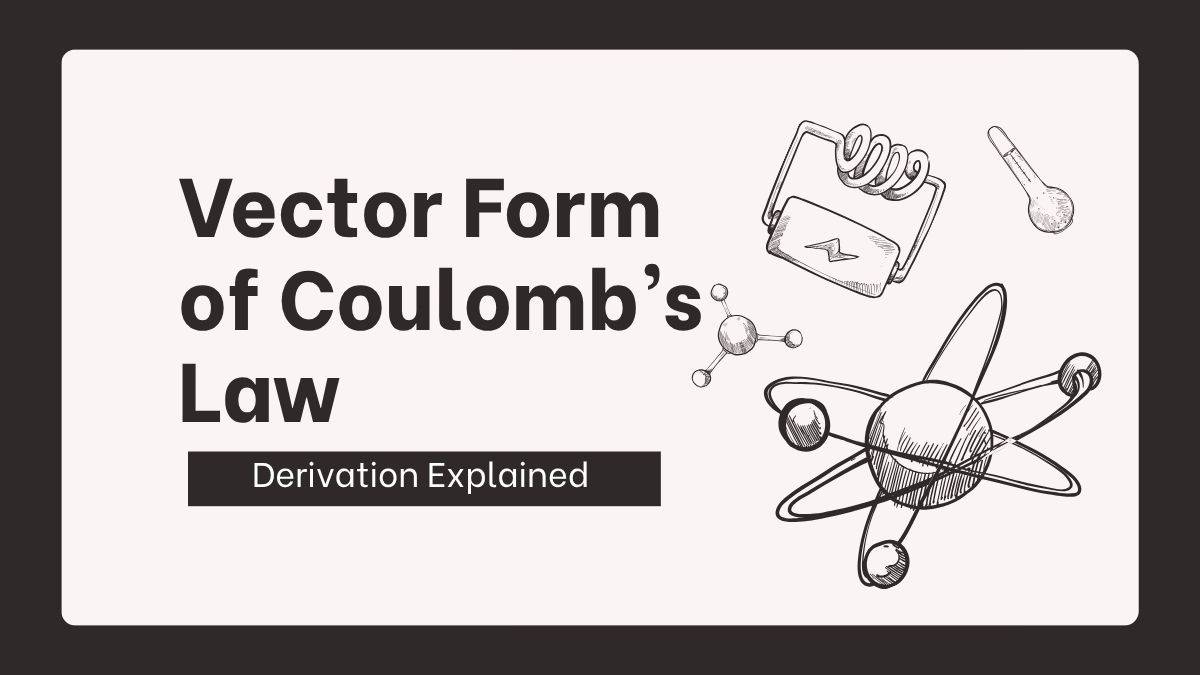Vector Form of Coulomb's Law with Derivation Explained
We know, Coulomb’s Law is one of the most basic and important principles of electrostatics. More so, it helps us measure force between two point charges that have some distance.
But what do you think makes the vector form of Coulomb’s Law so important in electrostatics, then?
French physicist, Charles-Augustin de Coulomb showed that calculating electrostatic force is possible with two conditions. The force has to remain in direct proportion to the product of the magnitude of the two charges, q_1 and q_2. This electrostatic force also has to follow the inverse square law where it is in an inverse relationship to the squared distance between the two.
Until here, we are still using force as a scalar quantity. We know the strength between the two charges. At this point, we still can't tell where the force is directed between the two. And this is where we have to figure out using, more particularly, deriving the vector form of Coulomb’s Law.
Derivation of Coulomb’s Law in Vector Form
The derivation of the Coulomb’s Law in vector form is super important for gaining clarity in solving and practicing with the NCERT Exemplar Class 12 Physics Chapter 1 solutions.
You can confidently understand concepts such as the superposition theorem when calculating force between multiple charges, because so far in Coulomb’s Law we focus on two point charges and the strength/magnitude between them.
Add to that, you will be able to handle electric fields numericals and understand advanced concepts relating to continuous charge distribution and so on.
Starting with Coulomb’s Law in the Scalar Magnitude Form
We know how the magnitude of electrostatic force between two charges shows up like this:
Here,
|q_1| and |q_2| are charges with the magnitude
r is the distance between them
The Coulomb constant here is
which equals
The epsilon is the permittivity of free space
Till here, we don’t know in which direction the force acts. And we know force is a vector. To get a fuller picture, we need to know about that vector.
Bringing Vector for Understanding Force and Position
When dealing with electrostatic force, the essential is to know the direction: to which charge the force is applied - is it q_1 or q_2?
This is where we bring in position vectors r_1 and r_2. These can tell us, for now, where the locations of charges would be in that particular space.
And remember, that location is relative to a fixed origin.
Now when looking into which charge is exerting force on another, ie, from one location to the next in that space, we introduce the displacement vector concept. With it, we get to know from where q_1 goes to the other point charge location of q_2.
Now just see that if we take an example of a force on charge q_1 exerting from the charge q_2, we would mathematically show the displacement vector in this way:
r_12 = r_1 - r_2
Now we’ve built a reference for the direction of force that it goes from the location of q_2 to where q_1 is located. What’s next?
Using a Unit Vector for Correct Direction without Changing Scale
Remember scalar multiplication? If multiplying a vector by a scalar, the result is a vector.
In this part of the derivation of Coulomb’s Law, we need to convert the scalar magnitude so that we get which direction the force is. Just a multiplication of the unit vector with the magnitude will give us the true vector.
We should bring in the unit vector here, as it has a magnitude of just 1. The length of the original vector isn't important here. The unit vector tells us which direction it actually points to, while the length remains a single value of 1.
That’s how we get the correct direction with no scale change.
So when we want to express direction only from the q_2 charge to q_1. We simply take the displacement vector r_12 that points from q_2 to q_1. Then we divide by its own magnitude, ie, its length.
The Final Vector Form of Coulomb's Law
Now we can simply combine and substitute all this into the Coulomb’s Law or electrostatic force formula as
Here, F_1 is the force of q_2 on q_1.

